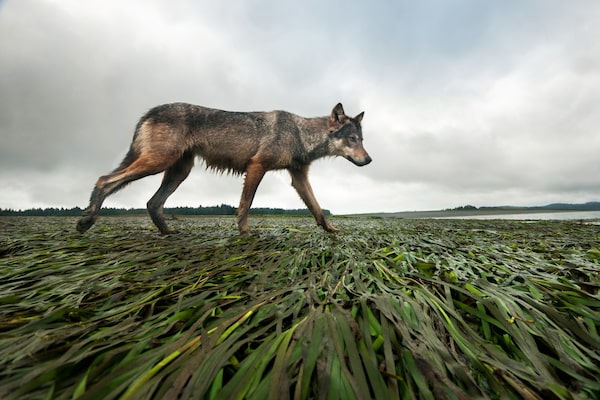Bertie Gregory films a fin whale off Elephant Island, Antarctica.Dan Beecham/Handout
At 29, British wildlife photographer and filmmaker Bertie Gregory has already documented some of the planet’s most majestic landscapes and threatened species. He began his full-time career in 2014 the day after graduating from university, when he travelled to South Africa to work on a project for National Geographic magazine. The designated National Geographic Explorer has worked on several award-winning films since then.
In his latest series, Epic Adventures (Disney+), Gregory takes viewers behind the scenes as part of the story, sharing what it takes to capture breathtaking encounters with wild animals on camera from Africa to Antarctica. But it was a trip to Vancouver Island 12 years ago and an unforgettable moment with a coastal wolf that helped turn his passion for photographing animals into a profession. Fresh from filming Season 2 of Epic Adventures, Gregory took time out to tell The Globe and Mail about how he got his start.

While out in his dinghy looking for black bears, Bertie spotted this female grey wolf trotting along the shoreline on the west coast of Vancouver Island.Bertie Gregory/The Globe and Mail
Your photograph of the wolf is so haunting. What brought you to that location in 2011?
I had just finished high school and I was going to study zoology at Bristol University here in the U.K. I had the summer and I really wanted to see bears. So I e-mailed a load of wildlife tour guides out on the west coast of Canada and said, hey, I like taking pictures and I’m young and really keen. This one guy called Mike replied and I came out and helped him on his bear-watching boat, which he did cruises on. He also had a little 12-foot rubber inflatable and he basically just let me loose on Vancouver Island. I learned how to be around bears safely. I learned how to find different animals – whales, sea otters, everything. And while I was there I came across this pack of coastal wolves and just got obsessed with them.
When most people think of wolves, they think of places like Yellowstone or maybe somewhere in the Arctic. And here was this animal who gets up to 90 per cent of its diet from the ocean.
How did you get the photo?
The alpha female of the pack is the one in that photo. I had a “bear box” for my camera – an indestructible housing that I had originally built to photograph black bears. It was a superlow tide that day. There was all this eelgrass that was very rarely uncovered. When I saw her from my boat I motored ahead and put the box down. Then I jumped back in the boat and backed off with a remote trigger for the camera. She walked past the camera and that was that; it was an incredibly lucky situation.
How much of a role does luck play in getting your best shots?
There’s a Scottish wildlife photographer called Lorne Gill. I remember he wrote somewhere that the more you practise, the luckier you get. That really sums it up. If you watch Epic Adventures, you’ll notice that we tend to get the big event, the thing we’re going for, towards the end. And some of my friends have said, of course you leave it to the end because it makes a better story. But that’s not it. It takes you that long to figure out how the animals work and what their cycles are. The end is when you tend to be in the right place at the right time to give Mother Nature the opportunity to make you lucky or not.
A gathering of Fin whales in the Southern Ocean.Bertie Gregory/Handout
There’s a memorable scene in the show where you come across a huge gathering of fin whales off the coast of Antarctica. What did it feel like to witness it in person?
We were anchored at a place called Point Wild on Elephant Island, which is right at the north end of the Antarctic Peninsula along the Drake Passage. It’s usually awful weather there but it was weirdly calm that morning. We picked up the anchor and headed out to where we’d seen the best evidence of whale gatherings before. I lifted up my binoculars and on the horizon, filling my binocular frame from left to right, were hundreds of big 20-foot high jets of water from the whales breaching at the surface, like cannons going off, backlit by the rising sun. It was one of the most extraordinary days of filming wildlife I’ll ever have.
How is your exuberance at seeing such an amazing sight tempered by the fact that so much of the wildlife you document is at risk?
The reason that the whale gathering in Antarctica was so moving for me was that it’s the best that it has been for decades. Thanks to the protection of whales in the southern ocean following the whaling era, the whales are coming back. That was really hopeful and inspiring to me. This is what happens when you give wildlife a chance.
This interview has been edited and condensed.
A fin whale during feeding.Bertie Gregory/Handout
The Australis pushes out to sea to look for whales from an anchorage at Point Wild, Elephant Island.Bertie Gregory/Handout
Bertie Gregory swimming with his underwater camera set up.Johnny Rogers/Handout
Scallop Hammerhead shark.Bertie Gregory/Handout
Bertie Gregory emerging camera-first through a huge mackerel bait ball.Handout
Bertie Gregory on boat in harsh Antarctic weather.Will West/Handout
 Ivan Semeniuk
Ivan Semeniuk